With the ocean swimming season kicking into gear once again, there are some important considerations that both the experienced and less experienced swimmers need to keep in mind. With the increased time spent in the water, often combining both pool and ocean swimming, there is an increased demand placed on the shoulder. As an example, consider a swimmer who completes a 3km ocean swimming session. During the session the swimmer will rotate their shoulder roughly 1800 times. Combining this with the increase in swimming sessions per week, the repetitive nature of the freestyle stroke and the continuous shoulder flexibility required for an efficient stroke, it is no wonder swimmers complain of shoulder pain.
A colloquial term for shoulder pain experienced by swimmers is ‘swimmer’s shoulder’, which describes the soft tissue injury where a tendon (connects the muscle to bone) becomes impinged underneath the bony arch that forms the top of the shoulder blade (scapula). When this injury is identified and managed early, time out of the water can be kept to a minimum without the risk of further complications.
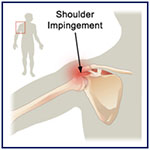
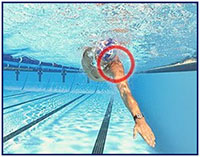
There are some signs and symptoms that ocean swimmers can look out for to help with early identification of ‘swimmer’s shoulder’. Swimmers may notice pain at the top, front or back of the shoulder and pain may radiate along the upper arm. This pain may be aggravated by overhead activities which can include the pull-through and recovery phases of the swimming stroke.
Research has identified many factors that contribute to ‘swimmer’s shoulder’. Two key muscles groups can become fatigued or imbalanced, which can lead to impingement. One is the ‘rotator cuff’ muscle group (see left image below) which controls the position of the upper arm bone (head of the humerus bone). The other is the ‘scapula stabilisers’ which control the position of the scapula (see right image below).
Both the rotator cuff and scapula stabilisers can become imbalanced and fatigued because of poor swimming mechanics, which reinforces the importance of stroke correction and recognising when breaks from water are needed. Research has also suggested that unilateral breathing may also contribute to the development of ‘swimmer’s shoulder’ by overloading one shoulder.
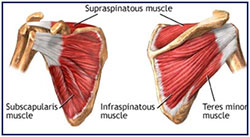
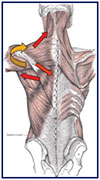
Left image: the front and back of the rotator cuff muscles that control the position of top of the upper arm bone (humeral head); Right image: the muscles that contribute to a balanced position of the scapula.
Until recently, strengthening the rotator cuff was the primary focus of rehabilitation for ‘swimmer’s shoulder’. However, recent research has now identified the importance of correctly strengthening the scapula stabilisers. The position and balance of the scapula muscles is the keystone to successfully preventing and rehabilitating ‘swimmer’s shoulder’.
The specific scapula stability exercises detailed below are examples of commonly prescribed exercises for swimmers experiencing shoulder pain and may be effective for prevention of ‘swimmer’s shoulder’. Research has found that appropriately training the muscles that control the scapula (also including the rotator cuff muscles) reduces the incidences of shoulder pain.
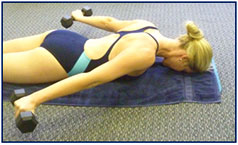
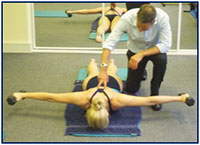
Examples of scapula stability exercises
Procedure – Scapula Stability Exercise
- Lie on your stomach with your palms facing down.
- Lift your shoulders off the floor gently by drawing your shoulder blades together.
- Once your shoulder blades are together, lift your arms off the ground and hold for five seconds
- Lower your arms first and then proceed to lower your shoulders down.
Start this exercise with a low weight (1-2 kilograms) and commence by performing the exercise with your arms by your sides. To make the exercise more challenging start with your arms at both 45 and 90 degrees (as pictured). Perform 3 x 10 repetitions.
Adequate shoulder range of motion is important for the catch phase of the freestyle stroke. Flexibility of the muscles on the back of the shoulder and back of the shoulder joint capsule can be achieved through the sleeper stretch (see image below) to help prevent ‘swimmer’s shoulder’.
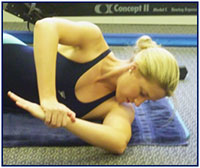
Procedure – Sleeper Stretch
- Lie on your shoulder in a position you might adopt when sleeping on your side
- Place your arm directly in front of you, with the elbow bent 90 degrees
- Using your other arm, push your hand down towards your feet, rotating your shoulder towards your feet
Perform 3 times and hold each stretch for 20 to 30 seconds.
Good luck with the upcoming ocean swimming season.
Yours in swimming,
Emma Fitzgibbon, Physiotherapist
